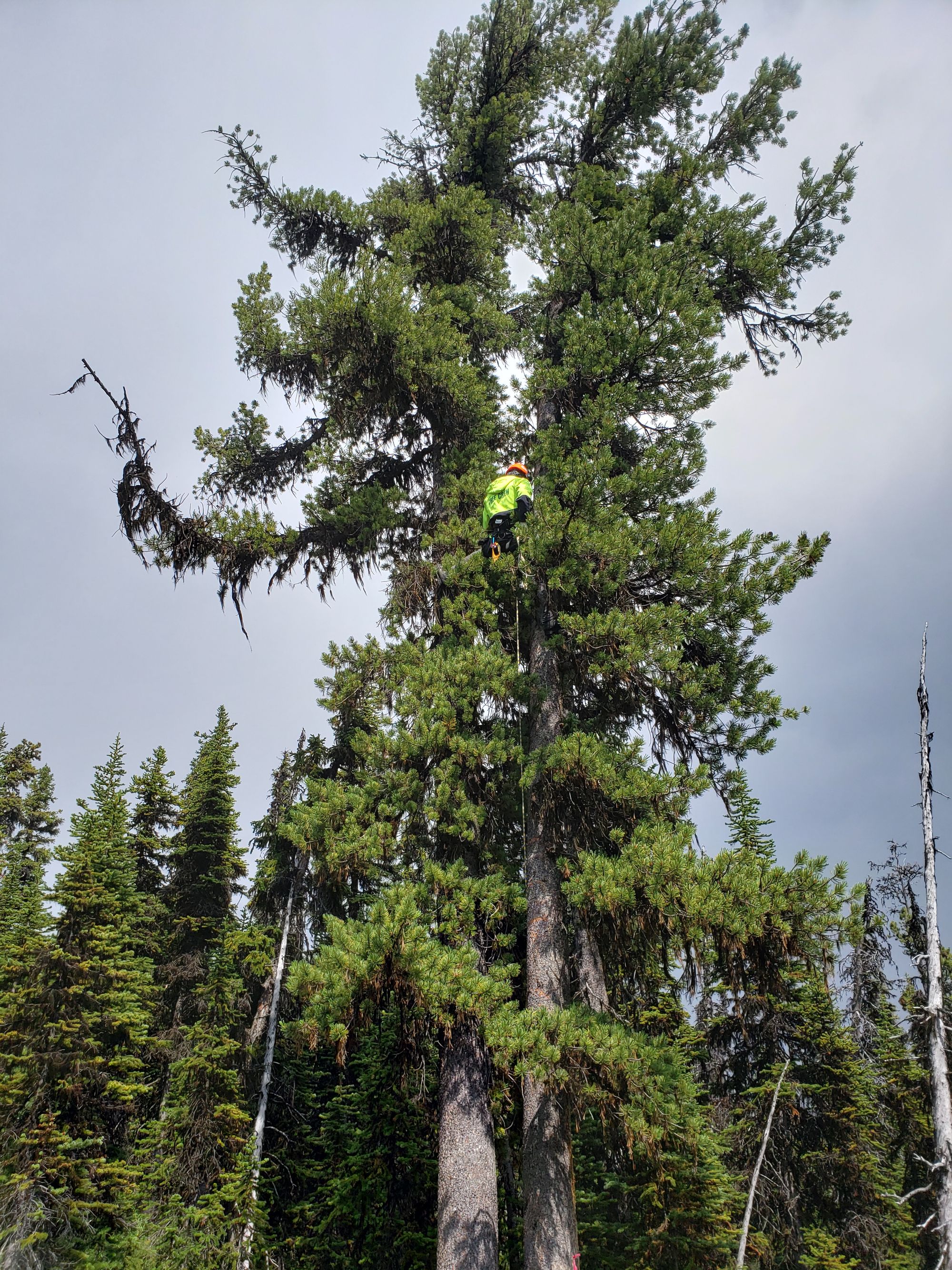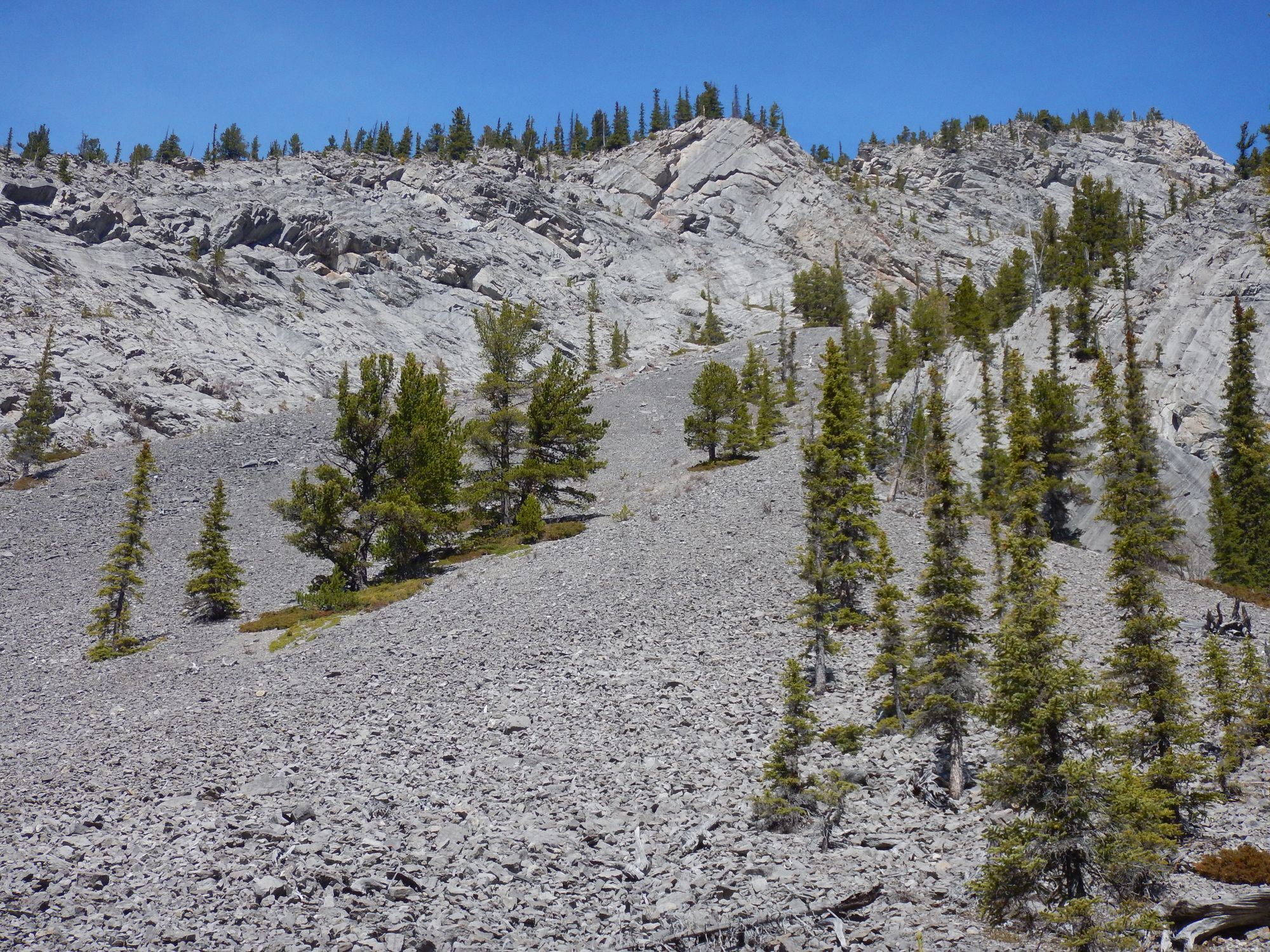Heading west past the Frank Slide in the Crowsnest Pass, you may happen to spot a dead tree silhouetted against the sky. The Burmis Tree was a long-lived limber pine. It has come to symbolize survival in tough conditions.
Whitebark and limber pine have needles in clusters of five as do the eastern and western white pine that are grown commercially. Growing in alpine and sub-alpine conditions, whitebark and limber pine grow amidst steep rocky slopes, ice, snow, and blustery winds. If that weren’t enough, they are now fighting to survive in the face of white pine blister rust (a fungus that affects all 5-needle pines), mountain pine beetle, mistletoe, and climate change.
Whitebark pine grow at high elevations in southern British Columbia. They vary in shape from a small tree with a broad crown to a shrub with multiple stems and upswept branches. The branches are twisted and gnarled if the tree is exposed to strong winds. The egg-shaped cones grow at right angles to the branch and are dark purple when mature.
Limber pine are smaller, scruffy trees. They are generally found at lower elevations than whitebark pine and have larger, yellowish-brown, cylindrical cones. Canada is at the northern edge of the limber pine’s range with the bulk of the population found in the United States. They can be seen on the edge of jagged rock escarpments in southern Alberta and southeastern BC.
Both whitebark and limber pine are foundation species. They grow where no other trees can and are one of the first trees to germinate after a mountain-top forest fire. Once in place, the pines create shelter, allowing other trees and plants to take root and grow. Pine nuts (seeds) are delicious – humans enjoy them as do 13 species of birds (including nutcrackers, chickadees, woodpeckers, crossbills, and pine grosbeaks) and 8 species of mammals (from chipmunks and squirrels to grizzlies and black bear). Mountain sheep, deer, and elk shelter under the trees’ branches. Humans benefit as well. Whitebark and limber pine stabilize the soil, preventing erosion, and shade the soil, moderating melt and regulating runoff.

Whitebark Pine Ecosystem Foundation of Canada
The Whitebark Pine Ecosystem Foundation of Canada is a boots-on-the-ground organization focused on recovery and restoration of whitebark and limber pine in the face of possible extinction. “We’re trying to beat the fungus genetically,” explains Barb Gass, the Foundation’s Executive Director. “We look for stands of trees that are highly impacted by whitepine blister rust and identify trees that are less affected.” Some of these trees will have genetic resistance; others will be older, stronger, or more tolerant. Identifying these trees may involve a helicopter ride or steep hike up the mountains, but it doesn’t end there.
Whitebark pine cones are found at the ends of branches at the very tips of the trees. This makes them highly accessible to their primary customer – the Clark’s nutcracker – but less so to humans who will need to climb the trees in the spring to place the cones in wire cages to protect them from being eaten and then go back up in the fall to harvest the cones. To make it even more complicated, the trees only produce a good crop every 2-4 years for limber pine and every 5-7 years for whitebark pine.
Once the cones are collected, they are dried and the seeds are carefully extracted and sent to seed centres in Alberta or BC where they will be safely stored. Each batch of seeds will be x-rayed to determine viability and germination potential. Viable seeds are then passed along to contract nurseries that will grow the seeds for the first 1-3 years to ensure they’re healthy and strong enough to be planted out.
The Foundation planted over 70,000 trees last year, but that’s not the end of the story. Whitebark and limber pine are open pollinated so there’s a great deal of variation. When infected with pathogens, some will do much better than others, so monitoring and consistent data collection as the trees develop is particularly important and an area that needs additional attention.
Each stage of this process is facilitated by the Whitebark Pine Ecosystem Foundation of Canada. The Foundation has experienced a growth spurt in the past two years with multi-year funding from federal and regional bodies. “Multi-year grants are key as they allow us to plan ahead. That’s so important when you’re talking about trees that take 50 years to mature,” Barb says.
In addition to contracting Barb as part-time executive director, the Foundation has hired a seed orchard manager to oversee seed orchards where they can plant seeds from resistant families in locations where it will be easier to access and collect the seeds. The orchards (3 at present with more under consideration) are in different regions and in different layouts to see what works best.

Can You Help?
“The trees are at great risk, but there is still hope,” Barb says. “We’re a small organization with limited capacity, so we rely heavily on volunteers.” You don’t need to be able to climb trees or hike for miles as the foundation is looking for help in many different fields, including marketing and promotion, grant-writing, accounting, policy development, photography, and event management. If you love trees and have appreciated the whitebark and limber pines as you hiked or skied in the mountains, do get in touch with Barb at barb@whitebarkpine.ca and let her know how you can help.
Ski Hills: The Whitebark Pine Ecosystem Foundation of Canada has created a certification program to encourage ski areas to conserve and restore whitebark and limber pine.
Photo credits: photo 1 (limber pine) and photo 3 (limber pine) - J. Krakowski, photo 2 (whitebark pine) - H. Mizera
EcoFriendly West informs and encourages initiatives that support Western Canada’s natural environment. Like us on Facebook, follow us on Twitter, or subscribe by email.
